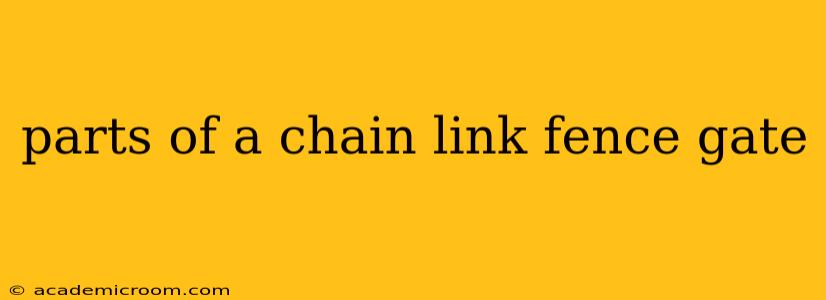Decoding the Components of a Chain Link Fence Gate: A Comprehensive Guide
Chain link fence gates, while seemingly simple, are composed of several crucial parts working in harmony to provide secure access. Understanding these components is key to installation, repair, and maintenance. This guide will break down the essential parts of a chain link fence gate, answering common questions along the way.
What are the main parts of a chain link gate?
The main components of a chain link gate include the frame, the chain link fabric, the hinges, the latch, and the posts. Let's delve deeper into each:
-
Frame: This is the foundational structure, usually made of galvanized steel pipe or tubing, providing the rigid support for the entire gate. The frame's dimensions determine the gate's size and opening. It typically consists of top and bottom rails, and vertical supports or stiles, all welded or bolted together for strength and stability.
-
Chain Link Fabric: This is the woven wire mesh that is stretched and attached to the frame. The fabric's gauge (thickness of the wire) and mesh size (spacing between the wires) determine its strength and security level. It’s vital to ensure the fabric is properly tensioned to prevent sagging and maintain the integrity of the gate.
-
Hinges: These are the connecting points between the gate frame and the fence posts. They allow the gate to swing open and closed smoothly. Different types of hinges exist, including self-closing hinges, heavy-duty hinges for larger gates, and those designed for specific post types. Proper hinge placement is critical for smooth operation and preventing binding.
-
Latch: This secures the gate in the closed position. Latches vary widely in design, from simple hook-and-eye latches to more secure, self-locking mechanisms. The choice of latch depends on the level of security required. Consider factors like ease of use, resistance to tampering, and overall durability.
-
Posts: These support the gate and provide a solid anchoring point for the hinges. Posts can be made from various materials, including metal or wood, and are typically set in concrete for stability. The posts' strength and depth significantly influence the gate's overall resilience.
What are the different types of chain link gate latches?
There's a wide variety of latches available, each offering different levels of security and ease of use. Common types include:
- Standard Hook and Eye Latch: A simple and cost-effective option, easy to install and use, but less secure than other options.
- Sliding Bolt Latch: Provides more security than a hook and eye latch, as it slides into a receiver, making it harder to force open.
- Padlock Latch: Offers the highest level of security, as it requires a padlock for opening, significantly deterring unauthorized access.
- Self-Closing Latches: These automatically close the gate, enhancing convenience and security.
How do I choose the right chain link gate for my needs?
Selecting the appropriate gate involves considering several factors:
- Gate Size: Measure the opening carefully to ensure the gate fits perfectly.
- Material: Galvanized steel is the most common and durable material, offering resistance to rust and corrosion.
- Latch Type: Choose a latch that balances security and ease of use, based on your specific needs.
- Weight Capacity: Ensure the gate can withstand the expected load, considering potential use and weather conditions.
How much does a chain link gate cost?
The cost of a chain link gate varies based on several factors including size, materials, and features. Expect prices to range from relatively inexpensive for basic models to significantly more for larger, heavier-duty gates with enhanced security features.
Understanding these components empowers you to make informed decisions when selecting, installing, or repairing your chain link fence gate. Remember to always prioritize safety and security when working with fencing materials and equipment.
